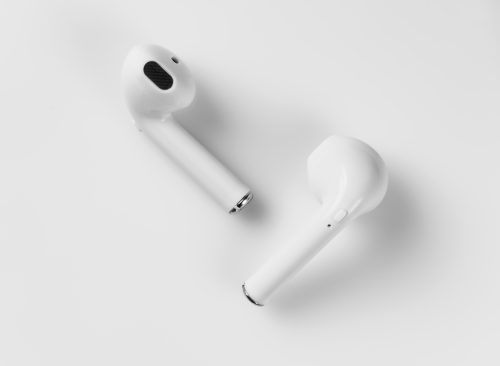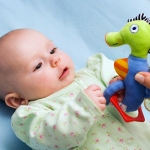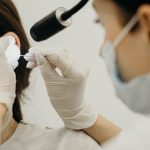Hearing loss is on the rise in young people and good habits should start at an early age. Cher Zhao, MD, spoke with Focus on the risks of noise-induced hearing loss in children, and best practices for prevention.
With increases in headphone usage through video games and other popular technologies like ear buds, it is essential to examine the possible risks of noise-induced hearing loss in children. The accessibility of electronics to children has exploded since the 1980s, and in turn, is attributing to new staggering numbers in hearing-related issues. According to the recent research, among American teenagers, aged 12 to 19, at least 15 percent experience “low- or high-frequency hearing loss of at least 16-decibel hearing level in one or both ears.”
According to Cher Zhao, MD, a pediatric ENT specialist at Mass Eye and Ear, a 16-decibel hearing loss can be “pretty significant.” For example, a typical conversation is 50 to 60 decibels while whispering is 30 decibels. Even a minor increase or decrease in decibels results in a huge change in noise, she said.
“The sad part is that noise-induced hearing loss is usually permanent,” Dr. Zhao told Focus. “It’s preventable, but you cannot recover that hearing loss.”
These statistics are staggering, and the numbers are steadily increasing. But how does noise-induced hearing loss occur, and how can it be prevented in the first place?
The science of noise induced hearing loss
A common image to come to mind when discussing noise-induced hearing loss is that of a heavy metal rock concert, or a crowded event. However, Dr. Zhao explains that the most common way for noise-induced hearing loss to occur is by repeated and prolonged exposures.
Sound waves travel through the ear drums and three bones in the ear called the ossicles, which transmit the vibrations of these waves and send the sounds into the inner ear to the hair cells. The inner ear is host to hair cells, which are responsible for translating the sound waves into electrical signals that are sent to the brain for processing.
“Overstimulation can cause mechanical damage to these hair cells, and when that occurs, hearing loss happens,” said Dr. Zhao
Unfortunately, currently, there is no way to regenerate hair cells once they are damaged, though researchers including those at Mass Eye and Ear are hard at work looking towards discovering new treatments.
Headache of headphones
Headphone usage for video games, music and other listening activities are sometimes the biggest culprits in pediatric hearing loss cases. Personal audio devices, now more than ever, in times of virtual school and transition to online life, are being used by kids in high volumes.
 The specific type of headphone used may impact the amount of noise exposure risk.
The specific type of headphone used may impact the amount of noise exposure risk.
With surging popularity, ear buds are commonly chosen for convenience. However, Dr. Zhao warns these might not be the safest options.
“Over the ear headphones are safer, especially for children, since the source of the sound is farther away from the eardrum,” she said. An ear bud being inside the ear canal can raise the sound by 6 to 9 decibels, she explained.
Noise-cancelling headphones are usually the best option. “It’s because when the outside background noise is cancelled, you don’t have to raise the volume of the music as high,” she said.
Signs to spot
How do you know if you or your child could be suffering from hearing loss? Initially, symptoms may be hard to tell, which reiterates the importance of regular hearing checks. “The higher frequency hearing is affected first,” Dr. Zhao shared. “You may not even notice it at first, which is what’s scary,” she said.
As the hearing loss progresses, repeated ringing or buzzing in the ears (tinnitus) may occur, as well as sensitivity to sounds. Conversations in a louder environment can become muffled and harder to hear too.
Mild levels of hearing loss can affect kids emotionally, socially, and educationally. “A child who cannot hear well may struggle to keep up in class and school, and even become disengaged from lessons,” Dr. Zhao explained. “Neglecting this can lead to behavioral problems and lower self-esteem.”
If you suspect your child is suffering from noise induced hearing loss, there are some steps recommended to be taken to ensure it does not worsen. Most primary care offices offer basic hearing screenings, and as well as schools. Depending on the results of such screenings, your child may be referred to an audiologist, or a more specialized doctor to help them achieve the best care possible. Unless there is a sudden or specific incident that triggers immediate hearing loss, there is no need to go directly to an emergency department.
Tips about good habits
Luckily, there are several preventable steps to take to minimize the chances and effects of noise-induced hearing loss. Dr. Zhao shared that sticking to a 60 percent, 60-minute rule can reduce the chances of hearing loss.
“Using personal audio devices for less than an hour, and at 60 percent of their maximum volume can prevent repeated and prolonged exposure that leads to damage.”
If longer usage is needed, the best way to protect your hearing is to unplug and take intermittent breaks.
There are settings or apps on mobile devices that aid in setting daily and weekly maximum volume levels to prevent hearing loss.
If you are at a loud event, like a concert, there are ear plugs that can reduce the amount of noise exposure without lessening the ability to hear the music.
Lastly, it is never too early to start protecting a child’s hearing. If you have a baby or toddler and are attending a loud event, Dr. Zhao recommends picking up a pair of hearing protection, noise-cancelling headphones. Also be mindful of loud toys for babies and toddlers; parents can download an app to measure the decibel level to make sure it is not over 70 decibels, which could be dangerous for hearing.



